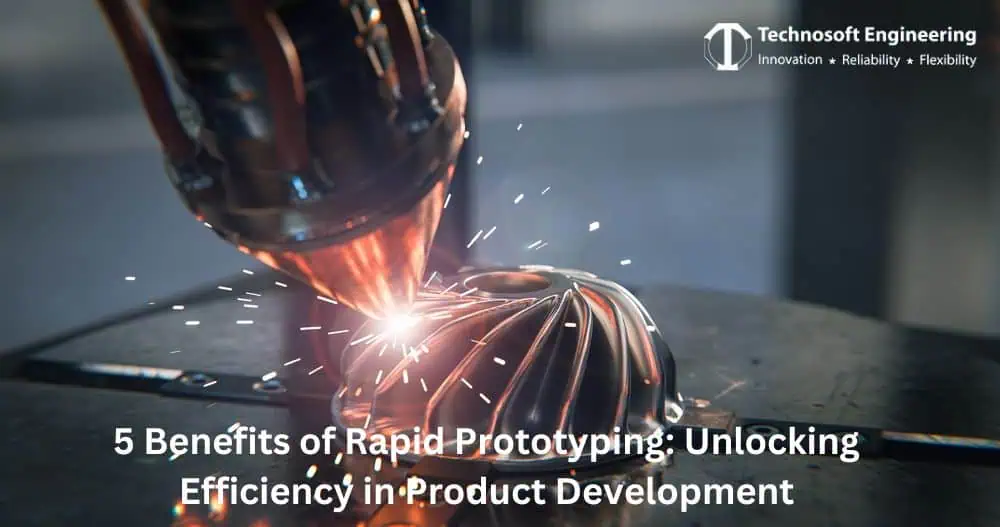
Rapid prototyping has become a significant factor in the fast-growing world of product development. It empowers businesses to swiftly implement ideas, test functionality, and identify areas for improvement without committing to the entire large-scale production process. This empowerment is a critical aspect of the product development cycle, as it instills confidence and control, leading to improved outcomes.
We will examine the five major advantages of rapid prototyping and analyze why they are important in the product development lifecycle.
1. Reducing Product Development Costs
One of the major advantages of rapid prototyping is its potential to significantly reduce costs. By creating prototypes early in the development process, organizations can identify and rectify model imperfections, enhance product features, and ensure market satisfaction without the risk of large-scale manufacturing costs.
Reduced iterations are often witnessed in conventional product development cycles, which are complete cycles that may end up being expensive in the long run. In the process of rapid prototyping, modification is easy to accomplish and does not require additional tools and redesigning. This reduces cost and enables a better production of products that a company intends to bring to the market.
2. Enhancing Functionality Testing
Rapid prototyping offers a unique opportunity to test the functionality of your product. Once a working prototype is created, you can assess how the product looks and functions in real-world scenarios.
Is it as good as people expected it to be? Prototyping addresses these questions and cannot be overemphasized. When it comes to the design of the product or service, one is able to test it and improve its design and usability. This stage also enables one to identify areas that may require some extra feature or enhancement.
3. Minimizing the Product Failure
One of the most sought-after benefits of rapid prototyping is its ability to minimize the risk of product failure. By addressing design issues during the prototyping phase, companies can avoid potential problems that could lead to significant financial losses once the product is launched.
When problems arise in the testing process, they can be addressed in the prototype, so they are not a major setback in the entire process. It is cheaper to warm or repair a prototype than to recall or repair a fully manufactured product that has already hit the market. Consequently, prototyping acts as a protective barrier from the costs and negativity that come with product defects.
4. Increasing the Engagement
The other advantage of rapid prototyping is its power for users and stakeholders. A tangible prototype gives both groups, consumers and business stakeholders, the ability to physically use and feel the product and give feedback on factors such as design, usability, and overall feel.
Such a partnership ensures that the product matches what is expected in the market as well as the objectives of the stakeholders. It also assists in developing confidence amongst the various stakeholders since they can monitor the project’s progress in which they invest. Thus, by incorporating this feedback into the final design and embracing the opinion of the target customers, companies can design and develop products that have the best chances of success in the market.
5. Constructively Assessing and Recognizing Product Risks
Another examination of the elements that can be used in developing new and improved products is Safety and usability, which are fundamental aspects of the overall procedure. Potential hazards or ergonomic problems can be easily seen and solved in rapid prototyping.
Prototyping also lets the designers get a feel for how the product will feel, function, and even fit into its environment. If the product is uncomfortable to use or perhaps safety issues are realized, they can be handled before large-scale production. This helps avoid situations where the end product may be admirable relative to set goals, effective, safe, and easy to use.
Conclusion
Rapid prototyping is a strategic prototyping service professionals offer. It has numerous advantages, including cutting costs and determining the crucial aspects of new product development in today’s increasingly competitive environment. Companies that use these services can enhance development time, improve their designs, and mitigate the possibility of designing wrong products, thus avoiding massive losses.
Are you serious about improving your product development? Learn how our prototyping services can help you cut expenses, fine-tune your concepts, and launch your product into the market more effectively. Contact Technosoft Engineering now, and let us help you go about the rapid prototyping procedure to make your following product a hit!